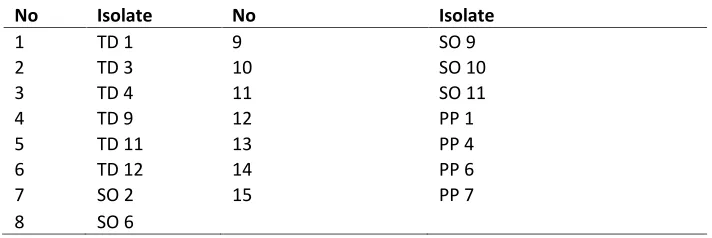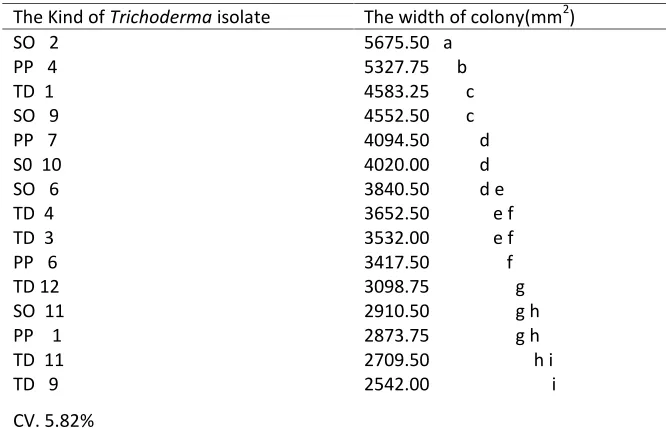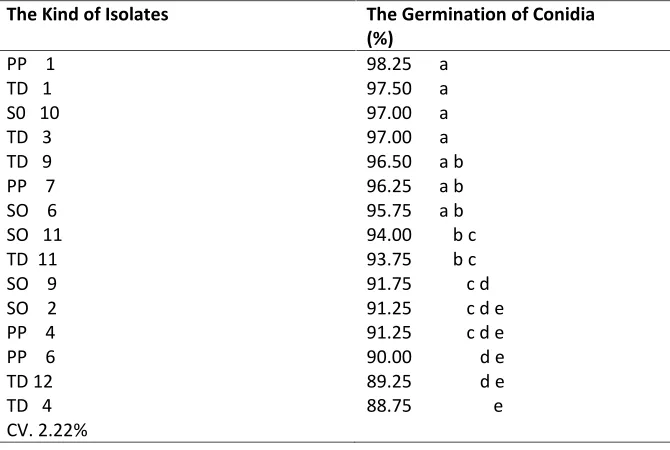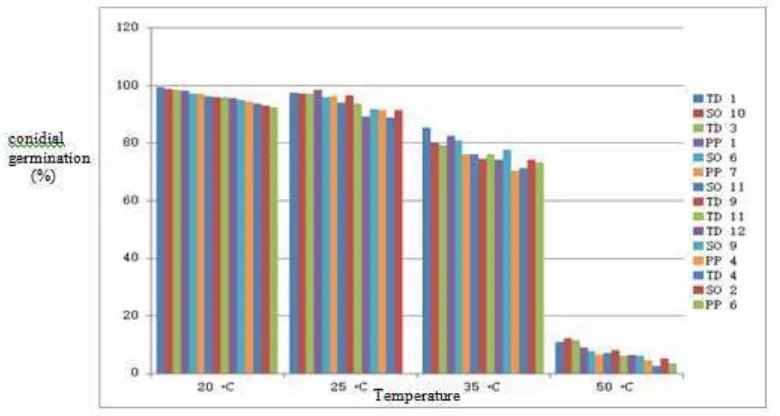Research Journal of Pharmaceutical, Biological and Chemical
Sciences
Viability and Temperature Effect to Conidia Germination of
Trichoderma
spp
Indigenous Banana Rhizosphere in West Sumatera Indonesia
Nurbailis, Martinius, Ujang Khairul, Vera Amelia
Department of Plant Plant Protection, Faculty of Acriculture, AndalasUniversity, Padang 25163, Indonesia
ABSTRACT
The purpose of this research was to study the viability and temperature effect on conidial germination of Trichoderma spp. indigenous banana rhizosphere in west Sumatera Indonesia. The experiment used Completely Randomized Design (CRD) with 15 treatments and 4 replications. The treatments were 15
Trichodermaisolates from various banana rhizosphere in West Sumatera Indonesia and had evaluated in vitro and in planta for biological activity against Fusarium oxysporum f.sp cubense. The observations were : the width of colony, production of conidia, the germination of conidia and conidia sensitivity to temperature. The result showed that the viability of Trichoderma spp isolated from various banana rhizosphere in West Sumatera Indonesia were different. Trichoderma isolates : TD1, SO10, were the isolates that had better viability than other isolates and more tolerant to high temperature.
INTRODUCTION
Trichodermaspp. are commonly found in all climatic zones, this fungi has habitat that dispersed in many kinds of soil and agriculture land. The most typical habitats of these fungi include soil and rotting wood [1,2]. Reference [3] reported that Trichoderma isolated from six different substrata and 49 localities in Poland, the highest diversity ofTrichodermaspecies was detected in the set of 22 isolates originating from soil, which included nine species (T. atroviride, T. citrinoviride, T. gamsii, T. hamatum, T. harzianum, T. polysporum,T. tomentosum, T. viride,T. viridescens).
According to [4] the colony ofTrichodermaspp. were different for each isolate, depend of species and strain. They were yellowish, yellow, white , green colour. Isolate that has green colour indicated that producted the dense conidia. According to [5] the ability ofTrichodermato suppress the growth of pathogenic fungus was determined by conidia germination. Several previously researches proved that isolates of
Trichodermaspp. had different abilities to suppress the growth of pathogenic fungus. Reference [6] reported four isolates ofTrichodermaconsisted of: three isolates wereT. virideand one wasT.harzianumfrom the tea ecosystem in North Bengal India indicated thatT. harzianumwas the best isolate in inhibiting the miselium growth of tea pathogens (Cortisium invisumandPestalotiopsis theae). Reference [7] also observed that 33
Trichodermaisolates from several banana production center in West Sumatera, in planta condition showed that different abilities to suppress the growth ofFusarium oxysporumf.sp. cubense (Foc). There were several isolates ofTrichodermaeffectively againstFoccaused Fusarium wilt disease of banana.
The difference of Trichodema isolates abilities to supress the growth of pathogens caused by the viability diversity of Trichoderma isolates and the tolerance of conidia germination to the temperature. According to [8], generallyT .harzianumcan grow well at 25-30°C on Potato Dextrosa Agar and increase the temperature at 37°C made reduce the growth and no growth was observed at 45°C after six days of inoculation. According to [9]Trichodermaspp from different agro climatic zone of India indicated that the ability of conidia to germinate of many isolates were reduced at 370C exceptT. asperellum-TaDOR673 and
this isolate effectively controlled the collar rot disease caused by Sclerotium rolfsii in groundnut when screenedin vitroandin vivo. [10] reported that The Maximum temperature for conidium production ofT. atroviride occurred at 25°C after incubation during 20 days. Germination of conidia that produced at 30°C more rapidly than the other temperature and gave the better bioactivity in comparison with incubation at 20°C or. 25°C.
The purpose of this research was to study about the viability diversity and the effect of temperature changes to conidia germination ofTrichodermaspp indigenous banana rhizosphere in west Sumatera that potential to suppress the growth of Foc.
METHODOLOGY
Design:This experiment used Completely Randomized Design (CRD) with 15 treatments and 4 replications. The treatments consisted of 15 Trichoderma isolates that isolated from various banana rhizosphere in West Sumatera Indonesia. All isolates had been evaluated in vitro and in planta for biological activity against
Fusarium oxysporumf.spcubense(Table 1, figure 1).
Table 1:Trichoderma spp.Indigenous Various of Banana Rhizosphere in West Sumatera Indonesia
TD = Isolate from Tanah Datar region; SO = Isolate from Solok region; PP = Isolate from Padang Pariaman region
Data had analyzed with ANOVA (Analisis of Variants) and followed by Duncan New Multiple Range Test (DNMRT) at 5% level.
Propagation ofTrichodermaspp. Isolates
Source of Trichoderma inoculum was obtained from several banana production center in West Sumatera Indonesia which was collected in Phytopathology laboratorium, Faculty of Agricultural, Andalas university. The isolates were rejuvenated again on Potato Dextrose Agar (PDA) for 6 days.
Preparing the suspension of conidia
Trichoderma spp were propagated in petridish that contain 10 ml PDA medium, then incubated during 6 days. After that conidia were removed by adding 10 ml of sterile distilled water and 0.05% Tween 80 as a spreader in a petri dish. Conidia removed from medium by using a soft brush. The cocentration of conidia was calculated by haemocytometer. The concentration used for the treatment was 106conidia ml-suspension.
Viability ofTrichodermaspp
The Width of colony, indicated by growingTrichodermafungal mat in the petridish that contain 10 ml PDA medium and then incubated at room temperature (280C) The width of colony was mesuared 2 days after
inoculation untill the petridish full well.
Evaluation of conidia germination. The conidia germination was determined with using slide culture. The method of slide culture : PDA medium with 1 cm2area and 0,5 cm thickness was placed on sterile object glass.
Then Dropped with 10 µl of conidia suspension that contain 106conidia ml-1suspension, and then covered
with cover glass. The slide culture was put in sterilized petridish which had been coated with whatman paper. Conidia germination was observed by using binocular microscope with magnifying 400x. Percentage of conidia germination was counted from 100 conidia. Conidia were clarified germinating of germination tube longer than diameter of conidia (figure 1) [11]
Production of Conidia. Production of conidia was determined in way, first,. each isolates of conidia suspension were prepared with the concentration 106conidia ml-suspension. then was took 0,1 ml and put in
petridish that contain of PDA medium. The culture was incubated for 6 days at room temperature (280C).
Subsequently conidia were removed by adding 10 ml of sterile distilled water and 0.05% Tween 80 as a spreader in a petri dish. Conidia removed from media by using a soft brush. The conidia suspension was put into Erlenmeyer flask and added 50 ml sterilized aquadest, vortexed for 5 minutes, filtered and diluted. Conidia concentration of each isolates was counted with haemocytometer.
Effect of Temperature changes to conidial germination
Conidia sensitivity to temperature was determined in way, conidia suspension was took 10 ml with concentration 106conidia ml-suspension from each isolates and then put into test tube. Each isolates were
treated with 200C, 300C, 350C and 500C during 30 minutes using waterbath. After treatment, the conidia viability of each isolates were determined with the same method on evaluation of conidia germination.
RESULT AND DISCUSSION
Viability ofTrichodermaspp.
The Width of Colony
Table 2: The Width of Trichodermaspp colonies that Incubated during 3 days at 280C
The Kind ofTrichodermaisolate The width of colony(mm2)
SO 2 5675.50 a
Four isolates of Trichodermathat identified the good growth were SO2, PP4, TD1 and SO9.. Four
isolates grew quickly, only 5 days could be able to complete the petridish. The isolate could grow quickly had a good competition againts pathogen. According to [12] fourTrichodermaisolates from north Bengal in India indicated that T. harzianum was the best isolate in inhibiting the miselium growth of tea pathogens (Cortisium invisumandPestalotiopsis theae).
Production of conidia
The amount of conidia production were different significantly among isolates ( 0,05). Four isolates were categorized as having height conidia production, those were TD1, TD3, SO10 and PP7 with average amount of conidia 3,20-3,69 x 1010ml-(Table 3)
Table 3: Conidia Production ofTrichodermaspp that Incubated during 6 days at 280C
The Kind of Isolates The Production of Conidia (ml
The figure in the column followed by the same lowercase letter are not significantly different according to DNMRT at 5% level
Trichodermaisolates; TD1, TD3 and SO10 producted more conidia than the others. In this case the good growth ofTrichodermaisolate not always indicated the good production of conidia. only TD1 isolate that had good relation between The growth and conidia production. This isolates had green colour full well than the others. Trichodermaisolate that had the green colour colony indicated that producted the dense conidia [8]. The best isolate as biological control agents must product the high conidia because the conidia is used as propagule for dissemination.
The Germination of Conidia.
Percentage of conidia germination of 15 Trichoderma spp isolates differed significantly ( 0,05). Generally conidia germination ofTrichodermaspp indigenous various banana rhizosphere were categorized good, above 88,70%. There were 4 isolates had high conidia germination i. e : PP1, TD1, SO10 and TD3 with average conidia viability 97%-98,25%. (Table 4)
Table 4. Conidia Germination ofTrichodermaspp that Incubated during 6 days at 280C
The Kind of Isolates The Germination of Conidia
All isolates that tested had good production of conidia. There were the relation between production of conidia with the conidia germination but not with the colony width. TD1, SO10, and TD3 that could product conidia highly also had the good conidia germination. Isolates with high conidia germination had big opportunity to cause antagonist mechanism. According to [9] the ability of Trichoderma to suppress the growth of pathogenic fungus was determined by conidia germination.
The viability of Trichoderma spp were different significantly among isolates ( 0,05). In this case caused by the different environment of native region of isolate that influence the growth and develop of
Trichoderma in vitro. Estimating that 15 Trichodermaisolates from the centra production of banana in west Sumatera consisted of different species or strain so each isolate had different viability. According to Reference [7] Trichodermaspp from different subtrata and places in Poland had the height diversity of morphological and moleculer analysis.
Treatment with various temperature influenced the germination of conidia significantly ( 0,05). At 200C and 250C germination of conidia of all isolates were high. All isolates were able to germinate above 90%.
Increasing the temperature caused decrease conidia germination. (figure 1)
Figure 1: Effect of Temperature changes to Conidia Germination
PP1, TD1 and SO10 isolates were tolerant to high temperature treatment. Three isolates still had high conidia germination at 350C. [14] reported that conidia ofT. stromaticumwas able to germinate about 95% at
temperature 200C-300C. The conidia germination of all isolates decreased at 350C and 500C. the reduction of
conidia germination was various according to isolate and temperature used. Each isolate ofTrichodermaspp gave different conidia germination response to temperature variation. At 350C the average of conidia
germination was 70,25-87,25%. At 500C conidia germination ofTrichodermawas very low, the highest conidia germination only 12%. This case was caused by at 500C is the above maximum temperature for germination of
Trichodermaconidia. According to [14], the maximum temperature for conidia germination of Trichoderma
spp were 370C.. PP1, TD1 and SO10 isolates were categorized as tolerant to high temperature treatment. The
three isolates still high conidia germination after treated with several rates of temperature
Two isolates ofTrichodermahad the best character were TD1 and SO10, those isolates had the good conidia production, conidia germination, and more tolerant to high temperature. The best character of those isolates had relation with ability to suppress Foc development, according to [11], TD1 and SO10 isolates had higher effectivity than other isolates in suppressing Foc infection in planta.
CONCLUSION
The viability of Trichoderma spp indigenus various banana rhizosphere in West Sumatera were different. There were two isolates that had better viability character and tolerant to high temperature than others. They are TD1 and SO10.
REFERENCES
[1] Samuel GJ. 1996. Trichoderma: a review of biology and systematic of the genus. Mycol.Res 100 (8): 923-935
[2] Druzhinina IS., Kopchinsky AG., Kubicek CP. 2006. The first 100 Trichodermaspecies characterized by molecular data. Mycoscience 47 (2): 55-64.
[3] Blaszczyk L., Delfina, P. Jerzy C., Grzegorz, K. Garys J.S.. Krzysztof and S. Marek 2011. Species Diversity ofTrichodermain Poland. Journal Applied Genetica 52 (2): 233-243
[5] Hjeljord LG,. and Trosmo A. 2003. Effect of germination initiation on competitive capacity of
Trichoderma atrovirideP1 conidia. Phytopathology 93 (12);1593-1598.
[6] Kabir SE, Depnath S, Mazumder A, Dey T, Bera B. 2016. In vitro Evaluation of four NativeTrichoderma
spp Isolates Againts Tea Pathogens. Indian Journal of Fundamental and Applied Life Sciences (on line). 6 (2): 1 -6
[7] Nurbailis, Mardinus, Nasril N, Abdi D, Trimurti, H. 2006. Penapisan IsolatTrichodermayang berasal dari Rizosfir Tanaman Pisang di Sumatera Barat untuk Pengendalian Penyakit Layu Fusarium. Jurnal Akta Agrosia. 9 (1) . 49 55.
[8] Gupta V, Sharma AK. 2013. Assesment of Optimum Temperature of Trichoderma harzianum by monitoring Radial Growth and Population Dynamic in Different Compost Manure and Different Temperatur. Octa Journal of Biosciences. 1 (2) 151-157.
[9] Poosapati S, Prasad DR, Navaneetha T, Dinesh KV, Sarad C. 2014. Selection of high Temperatureand Salinity TolerantTrichodermaIsolates with Antagonistic Activity AgaintsSclerotium rolfsii. Springerplus (3): 641,
[10] Daryaei A, Jones E, Ghazalibiglar EH. Glare TR, Falloon RE. 2016 Effect of Temperature, Light and Incubation Period on Production, Germination and Bioactivity of Trichoderma atroviride. Journal of Applied Microbiology,120 (4): 999-1009



